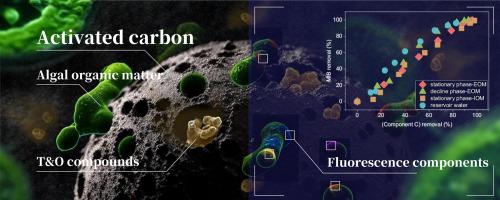Separation and Purification Technology ( IF 8.1 ) Pub Date : 2023-05-28 , DOI: 10.1016/j.seppur.2023.124206 Shaozhen Nie , Qi Wang , Yu Liao , Junzhi Zhang , Fan Yang , Shihao Wang , Min Yang , Jianwei Yu

|
Algae-producing odorants have negative effects on the aesthetic quality of drinking water, and activated carbon adsorption is commonly used to abate the odorants. However, in eutrophic waters, algal organic matter (AOM) produced by the dominant cyanobacteria (e.g., Microcystis aeruginosa) strongly interferes with the activated carbon adsorption of trace odorants from source waters. In this study, the applicability of using spectrometric surrogates to evaluate the effect of AOM from Microcystis aeruginosa on odorant adsorption by activated carbon was investigated. During the stationary phase, the DOC concentration of extracellular organic matter (EOM) increased due to algal metabolism (from 3.52 mg/L to 7.81 mg/L) and further accumulated (to 12.40 mg/L) during the decline phase due to the release of intracellular organic matter (IOM), resulting in increased competition against odorants. The adsorption of chromogenic organics in AOM was first evaluated to screen possible spectrometric surrogates for predicting odorant adsorption. The fluorescence component (Ex: 260 nm/Em: 400–460 nm) was the best candidate for predicting odorant adsorption in both AOM solutions and reservoir water. In contrast, poor performance was found for the commonly used UV absorbance at 254 nm and protein-like fluorescence components, due to the weak adsorbability of corresponding chromogenic materials. Our results indicate that fluorescence spectroscopy is promising in predicting odorant adsorption with AOM interference in source waters.
中文翻译:

藻类有机物对活性炭吸附 2-甲基异丙醇和土臭素的影响:藻类生长和腐烂的变化,荧光替代物预测
藻类产生的气味对饮用水的美观质量有负面影响,活性炭吸附通常用于消除气味。然而,在富营养化水域中,由主要蓝藻(例如,铜绿微囊藻)产生的藻类有机物 (AOM) 会强烈干扰活性炭对源水中痕量气味物质的吸附。在这项研究中,使用光谱替代品评估铜绿微囊藻AOM 效果的适用性研究了活性炭对气味物质的吸附。在静止期,细胞外有机物 (EOM) 的 DOC 浓度由于藻类代谢而增加(从 3.52 mg/L 到 7.81 mg/L),并在衰退期由于释放而进一步积累(到 12.40 mg/L)细胞内有机物 (IOM),导致与气味剂的竞争加剧。首先评估了 AOM 中显色有机物的吸附,以筛选可能的光谱替代物来预测气味吸附。荧光成分(Ex:260 nm/Em:400–460 nm)是预测 AOM 溶液和水库水中气味吸附的最佳候选。相比之下,常用的 254 nm 紫外吸光度和类蛋白质荧光成分的性能较差,由于相应的显色物质的吸附性较弱。我们的结果表明,荧光光谱在预测源水中 AOM 干扰的气味吸附方面很有前景。











































 京公网安备 11010802027423号
京公网安备 11010802027423号